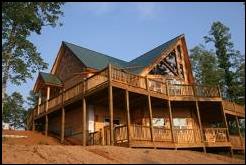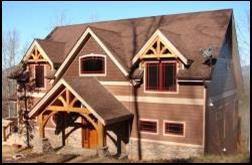

|
Green Building
To say there’s a lot of information about green building is an understatement. It is an important and increasingly mainstream topic. Everyone understands that a green house helps the environment. But green homes are also high efficiency homes. They are healthier, tighter and generally better built homes than conventional construction. In the long run, they will cost less to operate, be more reliable and have better resale value than conventional construction.
Our goal as a custom builder is to learn as much as possible on the subject so we can share this information with our Customers (see “Green Resources” below). In fact, education about green building is an important part of our monthly e-newsletter. Click here to sign up.
As we’ve become better educated on the subject of green building, several important facts stand out:
1. It’s not expensive. While some elements are pricey (and even those often justify their price tag), there are many options that require little or no investment whatsoever. All that’s required is getting educated and making some intelligent choices. In fact, building a certified green home (see “Certified Green” below) can cost as little as a couple thousand dollars. And when you add these additional costs into a thirty year mortgage, the monthly incremental costs are very low - usually less than the money saved on your electric bill.
In addition, there are many opportunities for incentives that help offset some of the additional costs. For a list of tax related incentives, go to www.dsireusa.org. Also, there are mortgage companies and lenders who will offer loan discounts for certified green building projects (ask us for additional guidance as these programs change frequently). 2. Every little bit helps. Much of the public focus about green building is on the big energy saving devices such as solar panels and wind turbines. However, building green encompasses all phases of construction and includes hundreds (maybe thousands) of options, devices, materials and construction methods that each contribute in part to helping the environment (see “Green Options” below). Berg Mountain Homes has already incorporated many of these ideas into our standard building practices. So even if you’re not ready to build a zero energy home, you can still do your part. 3. Energy usage isn’t the only thing. Green building is multi-faceted and includes site planning, material selection (sustainable, low maintenance, long lasting), waste management, water conservation and indoor air quality.
Certified Green
When building your custom home, it is easy to add energy savings or healthy features to your home. If you eventually sell that house, the only thing a prospective buyer has is your word that you were environmentally conscious. However, if you really want to have evidence of your level of commitment, a home needs to be certified as green by an independent third party.
In our area, there are two primary local programs and a couple national programs involved in non-profit green certification.
Earthcraft House - Based in Atlanta and affiliated with Southface, this is a regional program in the Southeast. Earthcraft’s checklist can be found here (choose climate zone 4).
NC HealthyBuilt Homes - This North Carolina program is affiliated with the Western North Carolina Green Building Council. Their checklist can be found here.
NAHB Green - Sponsored by the National Association of Home Builders and introduced in 2008, this program will likely become the national standard. NAHB Green’s checklist can be found here.
LEED for Homes - This US Green Building Council sponsored program is one of the most established programs, but unfortunately is also the most difficult and expensive to implement. Their checklist can be found here.
All these programs are fairly similar:
1. Each program has a checklist containing the various green options that are available during the construction process. The options each belong to a category such as site planning, energy savings, indoor air quality, water conservation, etc. In order to qualify for certification, the home must earn a certain number of points in each category as well as a certain number of points overall. Each program also has required elements as well as tiers indicating various degrees of commitment. 2. Prior to construction (or better yet, prior to design), you go over the checklist and determine which options you are going to pursue. Ideally, your builder should also be heavily involved in this process. And depending on the certification program, they may also offer guidance. 3. During construction, most checklist items must be verified through documentation provided by the builder and/or inspections. These inspections (usually two) are performed by an agent of the certification program or by a professional energy rater. The professional energy rater is trained to run tests on the house to determine its energy efficiency. These results are used to obtain an Energy Star rating which is a required element of some programs. 4. There is a lot of documentation and paperwork involved (which you can manage directly or you can pay a small fee to your builder to manage the paperwork). You also have to pay a fee to the certification program as well as for the services of the energy rater. The fees depend on the size of the house as well as the certification program, but can run from $1,000 to $2,000.
Green Options (click on the links for more information)
Low cost choices (many of these are standard for Berg Mountain Homes):
· Long lasting, reduced maintenance options such as vinyl windows (preferably Energy Star rated windows) and fiber cement siding. · Advanced framing techniques such as studs on 24” centers - the goal is to use less lumber and increase the amount of insulation in the home. · Wet spray cellulose insulation - made from recycled material, this insulation does a great job of sealing gaps and penetrations. · Properly sized A/C system with sealed ductwork and programmable thermostats; keep all ductwork in conditioned space. · Air tight house with little air leakage - sealed penetrations, spray foam around doors/windows, elimination of thermal bypass (air and heat moving around in the walls), zip system roof and wall sheathing (eliminates need for house wrap and roofing felt) - in our opinion, having a tight house is much more important than insulation. · Low or no VOC (volatile organic compounds) paint - conventional paint gives off toxic gases long after it’s applied to the wall. · Ceiling fans, compact fluorescent lighting (CFL), occupancy and motion sensors. · Low flow plumbing fixture and toilets. · Adding fly ash to concrete - uses up coal byproduct and reduces cement production (a major energy user). · Pre-plumbing a house for solar voltaic panels, solar water heating and/or radiant floor heating - if you aren’t ready for these relatively expensive options, preparing a house for their eventual installations can save thousands of dollars down the road.
Beneficial upgrades:
· Metal roofs - very long lasting and made from recyclable material; with light colors, can help reflect heat. · Reflective roof deck coating - metallic coating under your roof to reflect heat away from the house. · Variable speed air handler for your HVAC system - allows the fan to run more frequently at lower speeds; this means lower energy costs and a more comfortable home with less humidity. · Fresh air ventilation system - a tight house requires fresh air from the outside to be healthy. · Whole house air filters, dehumidifiers (for basements mainly), and humidifiers (for winter) · Tankless (on-demand) hot water heater - continuous hot water, uses less energy. · Spray foam insulation - expandable foam creates a very tight home. · Energy efficient appliances and front-loading washing machines. · Alternative materials (concrete/glass countertops, acid stained concrete floors, recycled shingles).
Complex solutions:
· Radiant floor heat - supplying heat through coils installed in the floor. · Geothermal heating and cooling system - use the constant temperature of the earth to heat and cool the house. · Solar water heating - letting the sun heat your water. · Solar photovoltaic energy storage - creating energy from the sun. · Rainwater collection system - from simple rainwater collection barrels to large cistern systems that supply a whole house with water.
Passive solar:
· Properly orient your home to capture warmth of the winter sun. · Properly sized overhangs keep sun out in summer and let sun in during the winter; general guideline for our area is to locate the sun’s shadow at window sill based on the June 21 sun angle (about 78 degrees at its peak). Try this sun angle calculator for other locations. · Thermal mass heat storage - concrete or water filled walls to absorb the heat during the day and release at night. · Daylighting - eliminating need for daytime lighting through strategic window placement. · Cross-ventilation - windows / screen doors that allow for air flow in the house as well as operable upper windows to release heat from the home.
Green Building Resources
www.energystar.gov – ENERGY STAR qualified products and practices help save money and reduce greenhouse gas emissions by meeting strict energy efficiency guidelines set by the U.S. EPA and DOE. The ENERGY STAR label also designates superior energy performance in homes and buildings. Berg Mountain Homes is a proud builder of ENERGY STAR labeled homes.
www.greenbuildingcookbook.info/Glossary.html - A glossary of green building terms.
green.wikia.com - Founded by the same person who founded wikipedia, this is a user contribution supported encyclopedia on green building. There are hundreds of articles on a wide array of subjects.
www.southface.org - An Atlanta based organization promoting sustainable building. They have a very useful resource center in their demonstration home. Southface also sponsors the EarthCraft House green building certification program.
www.usgbc.org - The US Green Building Council’s goal is to make green buildings available to everyone within a generation.
www.wncgbc.org – Western North Carolina Green Building Council (WNCGBC). A local non-profit whose mission is to support environmentally sustainable and health conscious building practices. They are a sponsor of NC HealthyBuilt Homes - a statewide North Carolina green building certification program.
www.dsireusa.org – Database of State Incentives for Renewables and Efficiency. A nationwide (state by state and federal) list of a wide variety of incentives for homeowners to invest in green technologies. Of note to area residents are the NC Renewable Energy Tax Credit and the Duke Power Energy Star 5% discount. On a national scale, there’s the Residential Solar and Fuel Cell Tax Credit and the FHA’s Energy Efficient Mortgage Program.
www.greenandsave.com – Green and Save. Returns on investment for various green building options.
www.livinggreenmag.com - An on-line magazine devoted to all aspects of sustainable living. Lots of links to other web sites as well as an on-line bookstore devoted to green subject matter.
www.wncgreenbuilding.com – A resource page from the WNCGBC. Includes articles, resources, an on-line directory of various green building providers and even a discussion forum.
www.ncgreenbuilding.org – A searchable North Carolina database of green built projects.
www.sustainablesources.com - A variety of green building topics are discussed in great detail.
|
|
________________________ Phone: (678) 646-1400
Copyright © 2007-2016 Berg Mountain Homes All Rights Reserved |
|
Home |
|
Meet the Bergs |
|
Mission and Values |
|
Why Berg Mt Homes? |
|
Custom Building Process |
|
Green Building |
|
Timber Frame |
|
Universal Design |
|
Photo Gallery |
|
Homes for Sale |
|
Lots and Land for Sale |
|
Design and Floor Plans |
|
Forms and Documents |
|
Resources and Links |
|
Referrals |
|
Contact and Affiliations |
